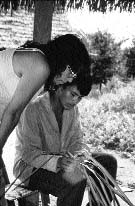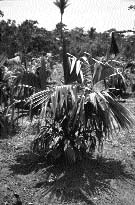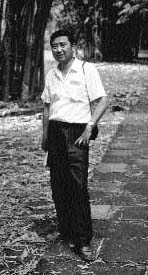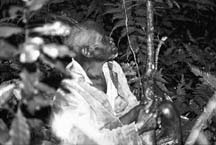Ethnobotanical
Portraits
Throughout the Handbook, you will
discover botanical bits and pieces: a
leaf here, a fiber there, a flower in the
corner. The task of identifying plant
parts, common to all ethnobotanical work,
is illustrated on these pages. Behind
each plant, you will find projects and
people, all involved with applying
ethnobotanical results to conservation
and community development in various
parts of the world.
-GJM
Background
 |
Seeds,
from which new ideas grow in the
Multimedia Center. This issue
features the seeds of Jatropha
curcas (Euphorbiaceae) which is
cultivated by Mixe Indian people
in the northern sierra of Oaxaca,
Mexico. Called locally pivayón
(probably a corruption of piñon,
the Spanish name for pine nuts),
it yields seeds which are roasted
and eaten as a snack
food. |
Jatropha curcas is used medicinally in
Latin America, the Caribbean and Africa
for a variety of health problems. The
information on Mixe use and naming of
this species comes from an ethnofloristic
inventory carried out by Mixe community
members in collaboration with a local
non-governmental organization called
Sociedad para el Estudio de los Recursos
Bióticos de Oaxaca (SERBO), and the
People and Plants Initiative. The
ethnobotanical team of SERBO is
participating in a WWF project on
people-centered conservation in
Oaxaca, with a focus on creating
educational materials on useful
plants and promoting the sustainable
utilization of selected species.
CONTACT
Rafael
García Soriano,
SERBO,
Porfirio Diaz 211, Apartado
Postal 533,Oaxaca, Oaxaca
68000, Mexico;
Tel./Fax
+52.951.60098,
e-mail
serbo@laneta.apc.org

. |
Textures,
weaving together viewpoints and
issues. Closeup of the brim of a
hat, woven from Carludovica
palmata (Cyclanthaceae), the
panama hat plant. The hat was
made in Totaizal, a Mestizo
community near the Beni Biosphere
Reserve in northern Bolivia.
Members of a neighboring village,
Galilea, have created an arts and
crafts center where they sell
locally-produced hats, baskets
and other objects made from
natural fibers. The villagers are
experimenting with the
cultivation of Carludovica in
home gardens, agricultural plots
and secondary forests. These
efforts are supported in part by
PEBENI, a project on plants and
ethnobotany of the Beni region,
which is carried out jointly by
the Beni Biological Station and
the People and Plants
Initiative.
|
CONTACT
- Inés
Hinojosa and Enrique
Uzquiano, Estación
Biológica del Beni, Av.
16 de Julio, No. 1732,
Casilla
5829, La Paz,
Bolivia;
Tel./Fax
+591.2.350612.
 |
Leaves,
carry readers’ comments in
the letters to the editor
section. Leaves from the sal tree
(Shorea robusta,
Dipterocarpaceae) are used to
make disposable plates in West
Bengal and other parts of India.
They are used as a substitute for
banana and lotus leaves, which
are becoming increasingly scarce.
In a study prepared for IBRAD
(Indian Institute of Bio-Social
Research and Development, to be
described in an upcoming issue of
the Handbook on community
forestry), Madhumati Dutta and
Manasi Adhikari write: ‘...
sal leaves are an important
non-timber forest product and as
long as the village people
produce plates from them, they
will not want their forest to be
destroyed. |
| Conversely,
as long as the forests are there,
villagers living in the
peripheral regions can make a
living out of the production of
sal leaf plates. Hence, there is
a strong two-way linkage between
forest regeneration and sal plate
making’ |
 |
From:
Dutta, M. and M. Adhikari. 1991. Sal leaf
plate making in West Bengal: a case study
of the cottage industry in Sabalmara,
West Midnapore. IBRAD Working Paper 2.
IBRAD, Calcutta.
CONTACT
- IBRAD,
3A Hindustan Road, Calcutta 700
029, India;
Tel.
+91.33.743105, Fax +91.33.766554
or +91.33.2482314. .
 Paper,
bears the title of each section.
This paper, made in Nepal from
lokta (Daphne bholua,
Thymelaeaceae) bark, is used for
greeting cards, briefcases,
folders and other handicrafts.
Hand-made paper from the
Himalayas is an ancient craft of
Nepal. The bark is harvested from
managed forests in the hills of
Nepal, and the paper is
manufactured by crafts-persons in
the town of Bhaktapur. Proceeds
from the sales are used for
community development activities
under a programme initiated by
UNICEF/Nepal. Paper,
bears the title of each section.
This paper, made in Nepal from
lokta (Daphne bholua,
Thymelaeaceae) bark, is used for
greeting cards, briefcases,
folders and other handicrafts.
Hand-made paper from the
Himalayas is an ancient craft of
Nepal. The bark is harvested from
managed forests in the hills of
Nepal, and the paper is
manufactured by crafts-persons in
the town of Bhaktapur. Proceeds
from the sales are used for
community development activities
under a programme initiated by
UNICEF/Nepal. |
CONTACT
- Bhaktapur
Craft Printers, P.O. Box 2205,
Bhaktapur, Nepal.
 |
|
|
 |
| Inés
Hinojosa,
PEBENI coordinator, watching as
Ascencio Lera weaves palm
leaves in San Antonio,
a
Chimane Indian community in
Bolivia. |
|
|
jipi-japa
(Carludovica palmata) cultivated
in an experimental plot in
Galilea, Bolivia. |
Back
Profiles

|
Pei Shengji
Pei
Shengji is Head of the Mountain
Natural Resources Division of
ICIMOD in Kathmandu, Nepal. He
was educated at the Chengdu
School of Agriculture and
Agronomy in China and received
advanced training in botany and
ecology from the Kunming
Institute of Botany, (Chinese
Academy of Sciences), University
of Hawaii at Manao and the
East-West Center in Hawaii,
United States. He gained much of
his ethnobotanical expertise
during the more than twenty years
he spent as researcher and
director of the Xishuangbanna
Tropical Botanical Garden in
Yunnan Province, China. He has
carried out research on many
topics, including biodiversity
conservation in temple yards and
holy hills of the Dai ethnic
region of Yunnan; the economic
botany of rattans and bamboo;
edible flowers of southern China;
and plant diversity in swidden
agroecosystems.
See
ICIMOD for his address.
|
 |
Jakob Bandusya
Jakob
Bandusya (Photo: R. Höft),
nearly 70 years old, is a
naturalist and master woodsman.
His parents came to western
Uganda from what is now Rwanda,
at a time before such boundaries
were defined by European
geographers. He has lived most of
his life in what is now Bwindi
Impenetrable National Park, a
crucial catchment forest and home
of a unique population of
gorillas.
|
He is
special not only in the depth of his
knowledge, but also in that he has
acquired land for his family to cultivate
when most of his people, the Batwa
pygmies, are landless share-croppers
working for Bakiga
agriculturalists.
Jakob has played an important role in
recording local peoples’ names and
uses of forest plants and insects. This
information, along with that from other
neighbors of the park, has led to the
zoning of multiple-use areas within the
park, enabling local people to have
continued access to forest resources,
paths and culturally important
sites.
Jakob is passing his knowledge on to his
many sons. One, Caleb Bandusya, is a star
gorilla tracker employed by the Institute
for Tropical Forest Conservation. Jakob
is currently working with Dominic
Byarugaba, a Ugandan graduate student
funded through the People and Plants
Initiative, to explore links between
Batwa traditional knowledge of stingless
(Meliponine) bees, pollination ecology
and resource use. Contact: Simon
Jennings, Institute for Tropical Forest
Conservation, P.O. Box 44, Kabale,
Uganda; Fax +256.486.22307.
Back
 |
What is
this . . . ? Did
you recognize the plant
scattered through these
pages?
It is Urospatha antisylleptica
R.E. Schultes, a plant in the
Arum family (Araceae). The ground
unripened spadix is used by
Barasana Indians of South America
for contraception.
|
| From:
Schultes, R.E. and R.F. Raffauf.
1990. The Healing Forest:
Medicinal and Toxic Plants of the
Northwest Amazonia. Historical,
Ethno- & Economic Botany
Series, volume 2. Dioscorides
Press, Portland, Oregon. Based on
Schultes’ fieldwork in the
Colombian Amazon - spanning more
than 50 years - and
Raffauf’s phytochemical
screenings, this compendium
describes nearly 1500 species of
medicinal and toxic plants,
representing 596 genera in 145
plant families. Contact:
Dioscorides Press, 9999 S.W.
Wilshire, Suite 124, Portland,
Oregon 97225, USA.
|
Back
|